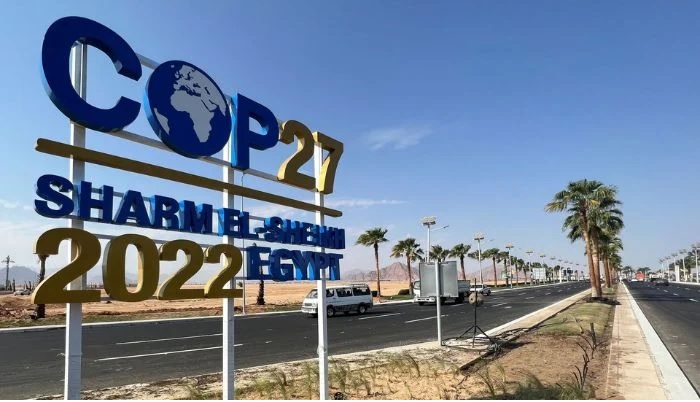
- The two major international entities which serve as the enabler of climate finance are Global Environment Facility and the Green Climate Fund (GCF).
- The financial resources are needed to be invested in large-scale initiatives such as solar panels, and electric vehicles, soon, which are notably lacking in developing nations.
- The ambition fixed by the developed countries on climate finance needs a significant change from what they were at the time of the Paris Agreement in 2015.
- Developing countries’ insistence on the new target by 2024 is simply making the rich vandals pay for their prior exploitation of the environment.
- Based on the principle of ‘common but differentiated responsibilities and respective capabilities’, it is fair for developing countries such as India to demand increased climate finance from developed countries.
On 6 November 2022, the Conference of Parties 27, popularly known as the COP-27 summit, commenced with lofty expectations in Sharm-El-Sheikh, Egypt. The discussion revolved around the rising energy crisis, greenhouse gas concentrations, and increased extreme weather events. This year ‘loss and damage’ finance is the official agenda, and ‘justice’ is at the heart of COP-27. Developing countries are calling on developed countries to help pay for a move towards a ‘net zero emission’ future and for the damage they have already caused. India has stressed the role of “rich countries” in undoing and cleaning their mess by paying their respective dues. The Indian delegation also emphasised that developing countries require “substantive enhancement” in climate finance beyond the floor commitment of $100 billion annually to reach the ambitious goals.
The Conference of Parties (COP) is an annual conference of the Convention’s parties where they discuss the state of the perennial fight against climate change. It was first held in March 1995 in Berlin, Germany. Since then, this meet has become a yearly occurrence in the global climate debate. As stated by the UN, “the COP is the supreme decision-making body of the United Nations Framework Convention on Climate Change (UNFCCC).” All those countries that are Parties to the Convention are represented at the COP, where they review the Convention’s performance and scrutinise legal instruments adopted by the COP. Furthermore, the COP makes the essential choices to support the Convention’s effective implementation, including institutional and administrative arrangements.
Climate Financing- The Need of the Hour
Climate finance came into existence as the world realized that to contain the burning of the earth and combat climate calamities. Certain countries need money and assistance from the rest. According to UNFCCC, ‘ Climate financing’ refers to local, national, or transnational financing drawn from public, private and alternative sources of financing to mitigate and adapt to the actions that will address climate change. The two major international entities which serve as the enabler of climate finance are Global Environment Facility(GEF) which has been functional since 1994. The second one is Green Climate Fund (GCF) which was introduced at COP 16, and in 2011, parties designated it as an acting entity of the financial mechanism for the climate.
The idea of “Climate Finance” came into focus when the Copenhagen Summit, also known as the 2009 United Nations Climate Change Conference, took place from 7-18 December 2009 in Copenhagen, Denmark. The conference featured the 5th session of the Conference of the Parties (CMP-5), serving as the Parties’ meeting to the Kyoto Protocol, and the 15th session of the Conference of the Parties (COP-15). One of this summit’s remarkable outcomes was the pledge developed nations made to contribute to initiatives aimed at helping underdeveloped countries adapt to climate change. Developed nations committed to providing $30 billion between 2010 and 2012 and securing $100 billion annually by 2020 in long-term financing from various sources. Formally leading to the recognition of “climate finance” at COP-16 in Cancun.
Climate Financing for NDC
Despite all that has been going on in this global environmental summit, why is ‘climate finance’ the matter in question for the majority? The climate actions to comply with the ‘nationally determined contributions (NDC) targets require financial assistance, technological changes, and capacity-building support from the developed countries. It is a significant and crucial tool in the fight against climate change since heavy investment in infrastructure is a prerequisite for controlling pollution and cutting back carbon emissions. The financial resources are needed to be invested in large-scale initiatives such as solar panels, and electric vehicles, soon, which are notably lacking in developing nations. So, to invest in green technology and renewable resources, climate finance is the foremost step for collecting abundant capital and paving the way for technology transfer.
The Urgency of Climate Calamities

The previous year (COP-26), India vigorously asserted that the transfer of climate finance and low-cost cleaner technologies had attained prime importance for implementing climate actions by the poorer countries. The ambition fixed by the developed countries on climate finance needs a significant change from what they were at the time of the Paris Agreement in 2015. India claimed that it was concerning how there has been little to no check on the progress of climate funding. It was emphasized that just as the UNFCCC tracks the developments made in climate mitigation, it should also track climate finance.
Additionally, it was clarified to the rich nations that India participates in the suffering of all other developing nations and hence chooses to speak up for them. India questioned the idea of “net-zero” emissions by 2050 being the only focus of developed countries. It demanded answers over the more urgent matter of “climate calamities,” for which they are responsible.
India’s Assertion towards Developed Countries to Contribute
This year (COP-27), Speaking at the UN Secretary-General at the launch of the “Early Warnings for All Executive Action Plan,” Environment Minister of India Mr Bhupender Yadav stressed that the global pace of climate mitigation and adaptation is unlikely to contain and suffice the rate of climate change. Referring to the work of the Intergovernmental Panel on Climate Change (IPCC), the Indian delegation underpinned that developed countries are the prime contributors to the carbon amassment in the atmosphere, and they need to reimburse for the same. India and other developing countries are pressing for a new global climate finance target. The new target called the ‘new collective quantified goal’ on climate finance (NCQG), would be in trillions of dollars per the Standing Committee’s financial estimations. The Committee revealed that resources in the range of $6 trillion to $11 trillion are required to meet the targets set by the developing countries in their NDCs. At the high-level ministerial dialogue on NCQG, Indian delegates called out the developed nations in 2009, decided (obsolete) a $100 billion floor amount, and demanded a check on the goal of climate finance.
The new target called the 'new collective quantified goal' on climate finance (NCQG) would be in trillions of dollars per the Standing Committee's financial estimations.
According to the Organisation for Economic Co-operation and Development (OECD) data, developed countries mustered $52.5 billion in 2013, which dropped to $44.6 in 2015. However, it has steadily jumped to $80.4 billion and $83.3 billion in 2019 and 2020, respectively mentioned in a factsheet published by the Centre for Science and Environment.
Developing countries’ insistence on the new target by 2024 is simply making the rich vandals pay for their prior exploitation of the environment. Moving forward on the path of “net-zero” emission and cleaner technologies is indispensable. It is justified to impose this responsibility on all countries. Based on the principle of ‘common but differentiated responsibilities and respective capabilities’, it is fair for developing countries such as India to demand increased climate finance from the developed countries. Stressing on action is valid, but capital accumulation and collective measures are urgent. International wildfires, floods in Pakistan, and heatwaves in Europe are some alarming examples of the urgency to address the matter of climate calamities.
We all are trying to progress and advance towards sustainable habits and goals. These actions, though, aim at a brighter and more promising future; undoing past mistakes is what the developing countries view as more consequential. Additionally, calling those who caused the damages to rectify them is perhaps the right of the developing and the underdeveloped.
(Bipsa Nanda is a Postgraduate Scholar in International Relations from the Department of Politics and International Studies, Pondicherry University, Pondicherry. Her interest area includes the geopolitics of climate change and the role of gender. Opinions expressed are author’s own)

A timely and pertinent article. The author points out that the developd countries are nothing but ‘Rich vandals’ . Words are not being minched here and rightly so.
It’s crucial that current generation is putting effort in the matter of climate change. A very article by Bipsa.